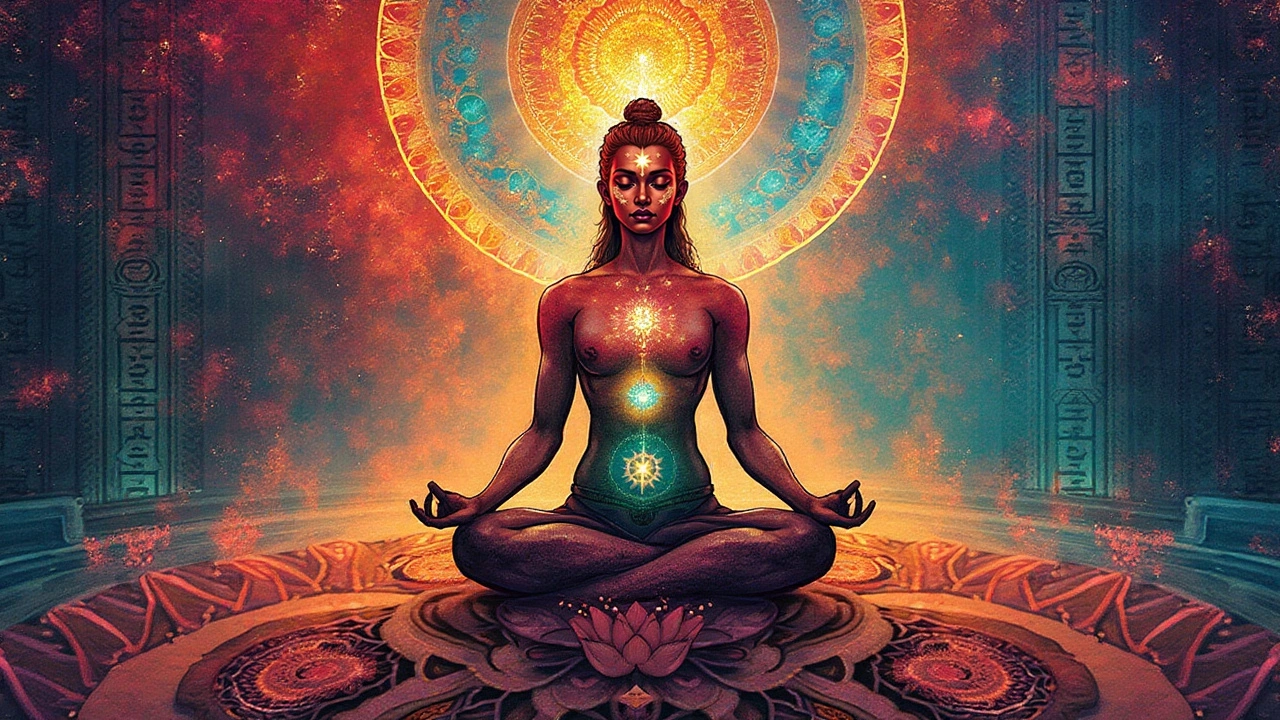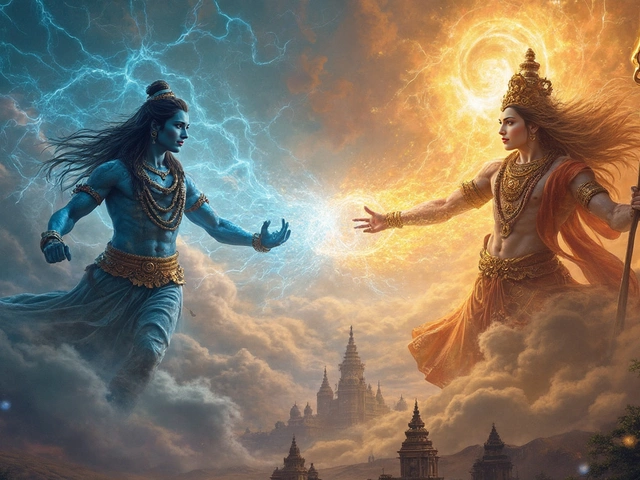Yoga, often seen as a path to physical wellness, extends far beyond balancing on a mat or steadying the breath. At its core, yoga invites practitioners into a realm of spiritual exploration, where the divine plays a central role. This isn't about aligning with a particular deity but rather, recognizing a universal consciousness that flows within and around us.
The journey involves connecting the dots between movement, breath, and the serene whispers of inner silence. Engaging with the divine through yoga means peeling back layers of perception to discover what lies beneath our everyday awareness. It's a voyage where philosophical insights and ancient teachings blend into today's practice, urging one to find harmony within.
For those seeking to enrich their practice with a deeper spiritual understanding, exploring this divine connection can transform yoga from a mere routine into a sacred ritual that highlights the interconnectedness of all life.
- Yoga and Spiritual Roots
- Defining the Divine in Yoga
- Sacred Texts and Teachings
- Meditative Practices and Divine Experience
- Philosophical Insights
- Integrating Divine Awareness in Daily Practice
Yoga and Spiritual Roots
Delving into the spiritual roots of yoga opens a portal to ancient traditions and philosophies that have long guided humanity towards self-realization and inner peace. Originating in India more than 5,000 years ago, yoga was first mentioned in the Rig Veda, an ancient sacred text of hymns and rituals pivotal to Vedic civilization. The practice itself was not initially about the physical postures popularly known today, but was a holistic discipline weaving together mental, spiritual, and physical elements to attain harmony and balance in life. Essential to this spiritual path is the understanding and interaction with the divine, which is perceived as an integral part of daily life and the universe.
An important aspect of yoga’s spiritual journey is its inclusive nature, acknowledging the divine not as a single entity but as a universal consciousness manifest in various forms throughout all beings and the cosmos. This theme is prominently featured in ancient texts like the Bhagavad Gita and the Upanishads, which provide philosophical insights into the concept of a universal spirit or 'Brahman' that connects each soul, or 'Atman', to the greater truth. Over time, these teachings have transcended cultural and geographical boundaries, inviting practitioners worldwide to seek their personal connection with the divine through mindful practices and meditation.
Yoga’s spiritual aspect is further enhanced by its relationship with meditation, a fundamental practice for realizing the unity of the self with the infinite universe. Meditation not only calms the mind but also opens pathways to deeper understanding and self-awareness, crucial for cultivating a divine sense of harmony. As Sri Aurobindo, an influential philosopher in integrating yoga with spirituality, once said,
"The mind, once expanded to the dimensions of larger ideas, never returns to its original size."This expansion through yoga is about tuning into a frequency that aligns our physical practices with our inner conscience, leading to profound spiritual awakening.
In contemporary settings, as yoga becomes increasingly popular, its spiritual roots serve as a reminder of the broader purpose beyond physical strength and flexibility. The practice encourages introspection and spiritual growth, inviting individuals to pause and listen to their inner psyche and the subtle whispers of the universe. While physical benefits are numerous and well-documented, the essence of yoga as a spiritual practice lies in its ability to link an individual’s inner journey with the universe’s boundless rhythm. This interconnection fosters a state of profound peace and spiritual elevation, making yoga more than a routine — a path to enlightenment.
Defining the Divine in Yoga
When seeking to define the divine within the realm of yoga, we must embark on a deeply personal journey. The concept of divinity here does not necessarily align with traditional religious imagery. Instead, it often represents a universal consciousness, an ever-present inner wisdom, or the essential life force connecting all beings. Practitioners of yoga, new and seasoned, are guided to discover this divine presence both internally and externally. This exploration is driven not by doctrine, but by practice and experience. The teachings within yoga provide a framework through which the notion of divinity becomes accessible, inviting individuals to sense and interpret it in their own unique ways.
The divine in yoga can be understood as a state of unity, the merging of mind, body, and spirit into a harmonious whole. This unity is not just about self, but about recognizing and honoring the sacredness in every aspect of life, leading one to feel an interconnectedness with the universe. Ancient scripts such as the Bhagavad Gita express this beautifully. In Chapter 6, Verse 29, it describes how a true yogi sees the divine in every creature and experiences everything as one. This perspective challenges practitioners to transcend beyond the ego, embracing a deeper connection with the world around them.
From a practical standpoint, achieving this sense of divine unity often involves meditative practices. These practices allow individuals to quiet the mind and open up channels to deeper spiritual insights. In silence and stillness, the clutter of daily thoughts dissipates, revealing the subtle cues of the universe. Classic yogic practices such as dhyana (meditation) and pranayama (breath control) are tools that help refine this internal awareness. Through disciplined practice, many individuals report experiencing a sense of oneness with nature or an inexplicable peace that fills the soul.
"In the silence of meditation, all masks fall away, and the divine within emerges," says renowned yoga master B.K.S. Iyengar, capturing the essence of yoga’s spiritual dimension.Embracing the divine often requires cultivating a mindset of reverence and mindfulness. With patience, practitioners learn to recognize moments of divine presence in their everyday lives, whether that’s in the simple act of mindful breathing, the beauty of a sunrise, or the serenity found in a quiet moment. This broader perception can lead to profound changes in how one interacts with the world, often fostering empathy, love, and compassion.
Ultimately, each individual's journey to define the divine in yoga is deeply personal, subject to one's beliefs, experiences, and openness. It is a journey without a concrete destination, but rich in experiences and lessons. By embracing the possibilities, one can begin to live a life infused with not just physical health, but spiritual richness. Engaging with these principles regularly forms a pathway that leads to a deeper understanding and embodiment of the divine, enhancing the simple act of practicing yoga into something truly sacred.

Sacred Texts and Teachings
In the rich world of yoga and spirituality, sacred texts form the foundation of understanding the divine essence that yoga seeks to connect with. These ancient manuscripts are more than historical artifacts; they are living guides that offer profound insights into the spiritual journey of yoga practitioners. Among the most revered texts are the Vedas, the Upanishads, the Bhagavad Gita, and the Yoga Sutras of Patanjali, each contributing uniquely to the practice's spiritual dimension.
The Vedas, perhaps the oldest of these texts, lay down the teachings that have been passed through millennia. They introduce the concepts of karma, dharma, and the cyclical nature of the universe, urging practitioners to harmonize their physical, mental, and spiritual selves. The Upanishads further delve into abstract metaphysical ideas, exploring the nature of reality and the soul's relationship with the universe. These texts challenge yoga practitioners to look beyond the tangible, encouraging them to perceive the underlying divine presence that pervades all existence.
Among these writings, the Bhagavad Gita stands out as a narrative and philosophical dialogue that explores the complexities of duty, spirituality, and the divine. In this epic scripture, Lord Krishna imparts wisdom to the warrior Arjuna on the battlefield, elucidating concepts of detachment, devotion, and understanding one's true self. The Gita's teachings underscore the importance of aligning one's actions with a higher purpose, tapping into the spirit of the divine as a guiding force. As the Gita suggests, "When a man dwells on the objects of sense, he creates an attraction for them; attraction develops into desire, and desire breeds anger."
By navigating these human emotions, the Gita advises us to seek a divine path beyond mere desires.
The Yoga Sutras of Patanjali provide a comprehensive guide to the practice of yoga, blending philosophy with practical instructions. These sutras present the eightfold path, or ashtanga, which includes ethical disciplines, physical postures, breath control, and meditation, all aimed at achieving ultimate spiritual liberation or Kaivalya. The Sutras emphasize the transformative power of meditation and the necessity of discipline in connecting with the divine. They serve as a manual for spiritual enlightenment, highlighting the importance of going beyond physical poses to cultivate a deeper connection with divine consciousness.
Through these sacred texts, practitioners gain insight into how to integrate meditative practices and philosophical teachings into their daily lives, enriching their spiritual journey. The teachings from these ancient manuscripts encourage individuals to seek the divine by balancing life's challenges with introspection and discipline. Whether one is immersed in the metaphysics of the Upanishads or the structured guidance of the Yoga Sutras, these texts invite a deeper reflection on one's spiritual path, reinforcing the core values that yoga represents. They embody the spiritual essence of yoga, offering timeless wisdom that continues to inspire seekers on their quest for the divine.
Meditative Practices and Divine Experience
Meditation in yoga is not merely a practice for calming the mind; it is a gateway to experiencing a sense of the divine connection. Through meditation, practitioners reach beyond the noise of daily life to touch the depths of spirituality. Regular meditative practices cultivate an inner silence that allows the individual to listen genuinely to the whispers of the cosmos. Many yogis describe this as the sensation of the universe unfolding within. Each meditation session is an opportunity to peel away layers of ego-driven thought, revealing the pure consciousness that underlies our existence. This divine essence, often referred to as the atman in spiritual texts, is considered the ultimate self — a fragment of the universal spirit, awaiting discovery.
The techniques used in meditation can vary widely, contributing to a personalized journey towards the divine. For some, focusing on a mantra or word provides an anchor for the mind amid the turbulent sea of thoughts. Others find stillness through mindfulness practices, observing the breath as it flows in and out, grounding them in the present moment. In this state, an individual may encounter what many describe as a profound serenity, a direct communion with something greater than themselves. Scientific studies also support these spiritual traditions, showing that meditation can lead to increased happiness, reduced stress, and even improvements in brain function. These benefits, while tangible, are mere steps on the path to experiencing the deeper, often indescribable, aspects of divine spirituality.
The Role of Sacred Sounds
Chanting and the use of sacred sounds can also play a significant role in drawing nearer to divine experiences in meditation. The repetition of these sounds, such as the renowned "Om," is said to resonate with the primordial vibration of the universe. This auditory tool serves not only to focus the mind but also to resonate with the physical and energetic body, creating a sense of holistic integration. Studies show that chanting can activate areas of the brain associated with positivity, further enhancing the spiritual experience. Those who engage in regular chanting often describe a unifying sensation, as if they become one with the sound. Such experiences affirm the belief shared by many that meditation is a bridge between the personal self and the universal divine.
"Meditation is not a means to an end. It is both the means and the end." - Jiddu Krishnamurti
These profound experiences are often unique to each practitioner, giving them personal insights and connections that yield new understanding and enlightenment. Meditation becomes more than a daily routine; it transforms into an exploration of existence itself, empowering practitioners to carry a sense of peace and connection into their lives. This myriad of benefits underscores why meditative practices are treasured aspects of yoga, holding the key to discerning the divine within and weaving it through the fabric of everyday life.

Philosophical Insights
The philosophical landscape of yoga offers a rich tapestry of ideas and practices that guide individuals towards spiritual enlightenment and union with the divine. Central to these philosophies is the concept of uniting the body, mind, and spirit to transcend the mundane. This notion is encapsulated in the Sanskrit word 'Yoga' itself, which means union or yoke. Historically, these insights have been drawn from a wellspring of ancient texts like the Bhagavad Gita, the Upanishads, and the Yoga Sutras of Patanjali, each offering a unique lens through which the divine may be understood and experienced.
In the Bhagavad Gita, for example, the discourse between Lord Krishna and Prince Arjuna on the battlefield is pivotal in understanding divine duty and personal dharma. The text speaks to the importance of aligning personal actions with a higher spiritual purpose, shedding light on how everyday duties can become a meditation when performed conscientiously and selflessly.
"Yoga is the journey of the self, through the self, to the self." - Bhagavad GitaEach line urges practitioners to see their lives as journeys toward an eventual spiritual awakening, guided by divine insight and internal reflection.
The Upanishads go even deeper, exploring metaphysical questions that challenge our understanding of existence itself. They invite individuals to see beyond the physical and temporal to reach the 'Brahman,' or the ultimate reality that permeates all things. This philosophical stance emphasizes that recognizing the divine in yoga is not about idolizing external deities but about coming into contact with the universal spirit within oneself. By internalizing such truths, practitioners are encouraged to cultivate a profound inner peace and discernment that shapes their perception of the world.
Meanwhile, the Yoga Sutras of Patanjali provide a framework for understanding the practice of yoga itself as a path to divine realization. The 'Ashtanga' or eight-fold path outlined in these sutras includes yamas and niyamas—ethical precepts akin to a moral compass—alongside physical postures, breath control, and ultimately, meditation. Together, these elements foster personal growth and spiritual maturation. Embedded within this framework is the recognition that connecting with the divine is a multi-faceted process that extends beyond physical practice, urging engagement with ethical and meditative disciplines.
There is an increasing interest and participation in yoga as a means to explore spirituality and achieve this deeper connection. Studies have surfaced illustrating how regular practice of yoga and meditation significantly enhances overall well-being and perhaps even spiritual insight. In today's busy world, where mindfulness often takes a backseat, these ancient philosophical insights provide timeless guidance on leading a more spiritually enriched life. For those willing to delve into these teachings, the reward is not only an enhanced yoga practice but also a greater harmony with the world and the divine essence of all things.
Integrating Divine Awareness in Daily Practice
Bringing a sense of the divine into everyday life through yoga involves more than just attending a class or rolling out a mat at home. It is about weaving a deeper spiritual awareness into the fabric of daily routines, allowing the essence of yoga's spiritual teachings to permeate every moment. This integration begins with recognizing that every mundane task, every breath, and every thought can become an opportunity for spiritual connection. A step towards incorporating divine awareness is through mindful meditation, best practiced not only in solitude but also when plunged into the chaos of the day. By aligning breathing with moments of silence, one learns to attune to a vibration of unity and acceptance everywhere.
To further embrace this concept, it's essential to understand the ancient principles that propel yoga beyond the physical realm. The sacred texts often resound with the idea that the divine is omnipresent, affirming that awareness is less about seeking outward and more about discovering within. This embodies the idea that the divine exists in the simplest acts—such as preparing a meal, working on a project, or even in conversations. Setting an intention each day can help focus the mind toward this profound presence. Whether saying a silent affirmation or reflecting on a short passage of spiritual wisdom, these practices keep divine mindfulness alive.
"Yoga is the journey of the self, through the self, to the self." - The Bhagavad Gita
Acts of kindness and service are also unparalleled in strengthening this connection. The Bhagavad Gita, for example, speaks of ‘Karma Yoga’—the path of action or selfless service—as a pathway to transcend the ego, thereby fostering union with the sense of the divine. This doesn’t always involve grand gestures; a simple act of helping, offering a smile, or listening to someone with empathy can be profoundly spiritual. Imagine incorporating small rituals, whether lighting a candle or taking a few moments of quiet gratitude, each meal can become an offering—a reminder that every aspect of life is sacred.
For a more structured approach, consider keeping a journal of divine connections. This can act as a personal log, detailing moments when you felt a deep sense of spiritual awareness or recounting daily experiences with gratitude. Over time, reflecting back on these entries can reveal a pattern of connectedness that strengthens your spiritual practice. Moreover, engaging with a community of like-minded individuals can enhance this growth. Whether through attending group meditations, participating in workshops, or simply having conversations with peers about spirituality and divine connection, community support can sometimes be the catalyst for nurturing spiritual insight.
In truth, integrating divine awareness does not necessitate any elaborate ceremonies or prolonged practices. Simplicity has the power to anchor the profound. What matters most is consistency and an open heart. With time, as this awareness expands beyond yoga sessions into all areas of life, it redefines not just the practice but the entire existence, creating a tapestry of divine experiences guiding every action and perception.





